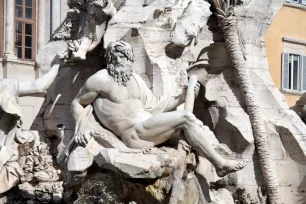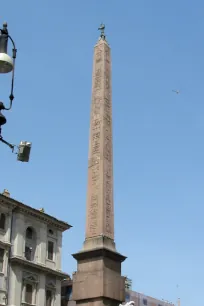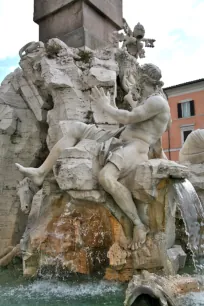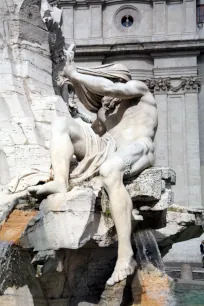The centerpiece of Rome’s beautiful Navona Square is the Fontana dei Quattro Fiumi (Fountain of the Four Rivers), one of the most famous fountains in the Eternal City. It was built in the mid-17th century after a design by Bernini.

The fountain, officially inaugurated in 1651, was commissioned by Pope Innocent X, an artistically-minded member of the Pamphilj-family. The fountain was financed with the income from an unpopular tax levied on bread, meat and salt.
Bernini
The fountain was created by Gian Lorenzo Bernini, one of the most celebrated sculptors in history. Innocent X initially preferred to work with Francesco Borromini instead of Bernini, who had received much support from the previous pope, Urban VIII. Since Urban VIII had been in conflict with Innocent X, the latter awarded the construction of the new fountain to Borromini, Bernini’s arch rival. However, Bernini created a model of his fountain and used his connections to influence the pope. After seeing the model, Innocent was delighted and assigned the project to Bernini instead of Borromini.
Design



Giant statues symbolize what were considered the world’s four greatest rivers: the Nile, the Ganges, the Danube and the Rio de la Plata. Each statue also represents one of the four continents that were known at the time. The giants rest on a large rock that rises from a circular basin and are surrounded by animals and flora of the respective continents. The fountain culminates in a tall obelisk that rests on a large plinth. The tip of the obelisk reaches a height of almost 35 meters (115 ft).
The Statues



The colossal figures of sea gods on the Fountain of the Four Rivers were sculpted by Bernini’s students. The master himself created the lion, sea creature and the palm tree.
The Danube, representing Europe, was created by Antonio Raggi. It supports the papal coat of arms of Innocent X, with a pigeon holding an olive branch in its beak. To his left sits an allegorical figure of the Ganges, created by Claude Poussin. The river personifies the Asian continent. The figure of the Nile (Africa) was created by Giacomo Antonio Fancelli. At the time, the river’s spring hadn’t been discovered yet, hence his face is symbolically covered by a cloth. The last allegorical figure is that of the Rio de la Plata, created by Francesco Baratta and representing the American continent. Coins near the figure allude to the rich minerals that had been discovered there.
During the Second World War, souvenir hunting American soldiers cut off the fingers of the statues, but they were replaced shortly after the war.
The Obelisk
The sixteen-meter tall (52ft) obelisk originally stood at the spina (the central wall) of the Circus of Maxentius, near the Via Appia Antica. It is not an authentic Egyptian obelisk, but a Roman version. It was created from porphyry on the order of the Roman Emperor Domitianus. On the top rests a pigeon, symbol of the Pamphilj family.
Borromini versus Bernini
There are several folktales surrounding the Fountain of the Four Rivers, inspired by the great rivalry between Bernini and Borromini.
Bernini’s fountain stands in front of the church of Sant’Agnese in Agone, a work of Borromini. It is said that the giant figures of the fountain show Bernini’s disdain for the church. The statue of the Rio de la Plata supposedly portrays the fear Bernini had for the collapse of the church. The Nile covers its head, so it wouldn’t have to see the church, and the other statues seem to turn away from the church in disgust. As a retort, the statue of St. Agnes on the church is said to have been placed in front of the fountain by Borromini to assure, with her hand on her heart, that the church will not collapse.
Another story tells that Bernini had made a mistake in the construction of the fountain, and as a result, there wasn’t any water flowing to the fountain from the aqueduct. Borromini, who looked forward to a debacle during the inauguration when the public would discover that the fountain didn’t work, couldn’t keep his mouth shut and told friends. Bernini got word of it and was able to fix the problem thanks to the clues he received from an acquaintance of Borromini.
- Next: Holy Stairs
- More Rome Fountains
- More Sights & Attractions in Rome

